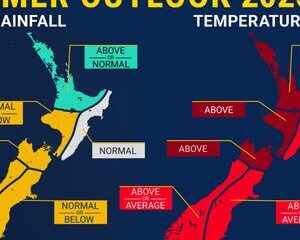Science
New Zealand Science Agencies Spend Over $270,000 on Rebranding

A recent expenditure report has revealed that newly created public research organizations in New Zealand have collectively spent over $270,000 on logo design, websites, and rebranding efforts. This significant cost comes despite the availability of a free government branding option, raising questions about fiscal responsibility.
According to figures released under the Official Information Act, Earth Sciences New Zealand, The Bioeconomy Science Institute, and The Public Health and Forensic Science Institute each incurred substantial expenses related to their branding initiatives. Earth Sciences New Zealand allocated $71,596 and logged 364 staff hours for its logo and website development. The Bioeconomy Science Institute spent $89,636, which included $42,735 in legal fees. Meanwhile, the Public Health and Forensic Science Institute reported costs of $68,714. Another agency, the New Zealand Institute for Advanced Technology, is still in the process of completing its rebranding.
The costs stem from a comprehensive overhaul of New Zealand’s science system, which merged six of the seven Crown Research Institutes into three larger entities starting from July 2023. Niwa and GNS Science combined to form Earth Sciences New Zealand, while AgResearch, Manaaki Whenua, Plant & Food Research, and Scion were combined into the Bioeconomy Science Institute. The former ESR has been restructured into the Public Health and Forensic Science Institute.
Shane Reti, New Zealand’s Science Minister, expressed his surprise at the spending, stating he was not informed of the costs beforehand. “I have made my expectation clear to the Boards of these new public research organisations that they are to operate in a financially responsible manner and look for efficiencies where possible, so they can focus on undertaking impactful research,” he remarked.
The spending appears to contradict guidance issued by the Ministry of Business, Innovation and Employment and the Public Service Commission, which encourages new or rebranding agencies to utilize a shared government identity. This includes a standard logo that incorporates the New Zealand Coat of Arms.
The Taxpayers’ Union, which obtained the spending figures through a series of Official Information Act requests, criticized the expenditures as “ego-driven” and “wasteful.” Investigations coordinator Rhys Hurley remarked, “These organisations are burning through taxpayer cash for flashy logos and websites, despite the free Coat of Arms being readily available for use.”
In response to concerns, Iain Cossar, the programme director for science system reforms at MBIE, noted that the ministry had advised former Crown Research Institutes to be fiscally prudent when making branding decisions. “Ensuring that customers and stakeholders can clearly identify and connect with these organisations remains a priority,” he stated.
Mark Piper, Chief Executive of the Bioeconomy Science Institute, confirmed that the agency had spent $46,900 on brand development and $51,000 on legal advice and trademark registrations. He emphasized the importance of a strong brand, stating, “Around half of our revenue comes from non-government sources, so having a clear and distinctive identity helps us connect with those clients, collaborators, and investors both in New Zealand and internationally.” Piper added that they are managing costs carefully during this process.
The Public Health and Forensic Science Institute indicated that it had incurred an additional $32,000 in expenses since the initial report, bringing the total spending to $100,714. A spokesperson for the organization clarified that, “Public Research Organisations are not Government agencies, so do not apply the NZ Government Identity per the Public Service Commission Guidance.” They noted that the government identity is meant to complement an organization’s brand, rather than serve as an alternative for rebranding.
Earth Sciences New Zealand also stated that it is not a government agency, hence the use of the New Zealand Government identity is not a requirement.
As these organizations continue to establish their identities, the fiscal implications of their branding choices remain a point of contention among stakeholders and taxpayers alike.
-

 World2 weeks ago
World2 weeks agoPrivate Funeral Held for Dean Field and His Three Children
-

 Top Stories2 weeks ago
Top Stories2 weeks agoFuneral Planned for Field Siblings After Tragic House Fire
-

 Sports3 months ago
Sports3 months agoNetball New Zealand Stands Down Dame Noeline Taurua for Series
-

 Entertainment3 months ago
Entertainment3 months agoTributes Pour In for Lachlan Rofe, Reality Star, Dead at 47
-

 Entertainment2 months ago
Entertainment2 months agoNew ‘Maverick’ Chaser Joins Beat the Chasers Season Finale
-

 Sports3 months ago
Sports3 months agoSilver Ferns Legend Laura Langman Criticizes Team’s Attitude
-

 Sports1 month ago
Sports1 month agoEli Katoa Rushed to Hospital After Sideline Incident During Match
-

 World3 weeks ago
World3 weeks agoInvestigation Underway in Tragic Sanson House Fire Involving Family
-

 Politics2 months ago
Politics2 months agoNetball NZ Calls for Respect Amid Dame Taurua’s Standoff
-

 Top Stories2 weeks ago
Top Stories2 weeks agoShock and Grief Follow Tragic Family Deaths in New Zealand
-

 Entertainment3 months ago
Entertainment3 months agoKhloe Kardashian Embraces Innovative Stem Cell Therapy in Mexico
-

 World4 months ago
World4 months agoPolice Arrest Multiple Individuals During Funeral for Zain Taikato-Fox





















